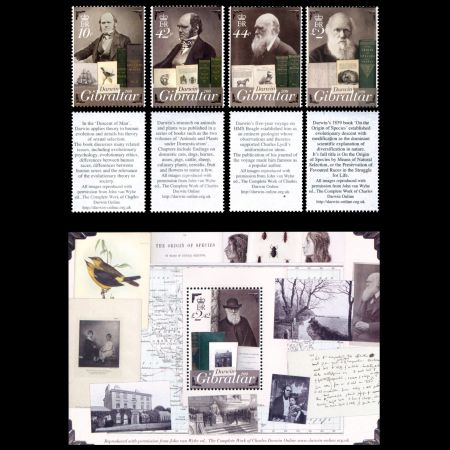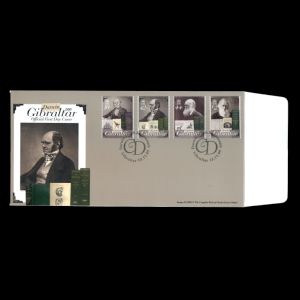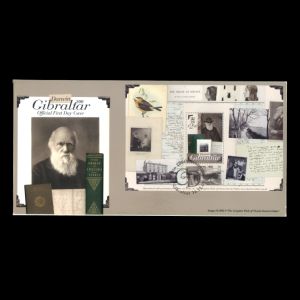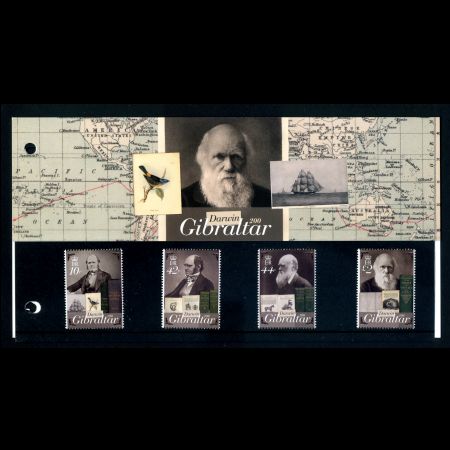the place where Paleontology and Paleoanthropology meets Philately
Gibraltar 2009 "Darwin 200th Anniversary"
| <prev | back to index | next> |
| Issue Date | 12.11.2009 |
| ID | Michel: 1349-1352, Bl. 90 (1353); Scott: 1211-1214, 1215; Stanley Gibbons: 1341a-1341d, 1341e; Yvert et Tellier: 1349-1352, BF91; Category: pF |
| Design | Stephen Perera |
| Stamps in set | 5 (4 stamps and Souvenir-Sheet with 1 stamp) |
| Value | 10p, 42p, 44p, 2, 2.42 |
| Size (width x height) | 30x40mm, MS 114x74mm |
| Layout | |
| Products | FDC x2, PP x2 |
| Paper | |
| Perforation | 14.25x15 |
| Print Technique | Offset Lithography, 4 colors |
| Printed by | Lowe-Martin, Canada |
| Quantity | |
| Issuing Authority | The Gibraltar Philatelic Bureau Ltd. |

On November 12th, 2009, the Post of Gibraltar issued the set of four single stamps and a Souvenir-Sheet "Darwin 200th Anniversary". The single stamps contain some text on the reverse side. These stamps reproduces images from "The Complete Work of Charles Darwin" website.
The year 2009 was both the 200th Anniversary or bicentenary of the birth of Charles Robert Darwin, and the 150th anniversary of the publication of his most famous work "On the Origin of Species by Means of Natural Selection". Many postal authorities around the world, including Ascension Island issued stamps to celebrate one or both of these a anniversaries.
Charles Robert Darwin FRS (12 February 1809 - 19 April 1882) was an English naturalist who realised and presented compelling evidence that all species of life have evolved over time from common ancestors, through the process he called natural selection. The fact that evolution occurs became accepted by the scientific community and much of the general public in his lifetime, while his theory of natural selection came to be widely seen as the primary explanation of the process of evolution in the 1930s, and now forms the basis of modern evolutionary theory. In modified form, Darwin's scientific discovery is the unifying theory of the life sciences,providing logical explanation for the diversity of life.
At Edinburgh University Darwin neglected medical studies to investigate marine invertebrates, then the University of Cambridge encouraged a passion for natural science. His five-year voyage on HMS Beagle established him as an eminent geologist whose observations and theories supported Charles Lyell's uniformitarian ideas, and publication of his journal of the voyage made him famous as a popular author. Puzzled by the geographical distribution of wildlife and fossils he collected on the voyage, Darwin investigated the transmutation of species and conceived his theory of natural selection in 1838. Although he discussed his ideas with several naturalists, he needed time for extensive research and his geological work had priority. He was writing up his theory in 1858 when Alfred Russel Wallace sent him an essay which described the same idea, prompting immediate joint publication of both of their theories.
His 1859 book On the Origin of Species established evolutionary descent with modification as the dominant scientific explanation of diversification in nature. He examined human evolution and sexual selection in The Descent of Man, and Selection in Relation to Sex, followed by The Expression of the Emotions in Man and Animals. His research on plants was published in a series of books, and in his final book, he examined earthworms and their effect on soil.
In recognition of Darwin's pre-eminence, he was one of only five 19th-century UK non-royal personages to be honoured by a state funeral, and was buried in Westminster Abbey, close to John Herschel and Isaac Newton.
Products and associated philatelic items
| FDC | First-Day-of-Issue Postmarks | |
 |
 |
 |
| Presentation Packs | Example of circulated covers | |
 |
 |
 |
| The reverse side of both Presentation Packs are identical, contain some technical details and the background information text. | ||
| Imperforate Stamps | ||
 |
 |
 |
| The imperforate stamps are very rare. | ||
References

|
- Technical details and stamps presentation: Gibraltar Post
- "The Complete Work of Charles Darwin" internet resource
- Representation of "Darwin 200th Anniversary" in Philately.
Acknowledgements:
- many thanks to Peter Brandhuber for his help and sharing scans of some unique philatelic material from his personal collection.
- many thanks to Dr. Peter Voice from Department of Geological and Environmental Sciences, Western Michigan University, for the draft page review and his valuable comments.
| <prev | back to index | next> |